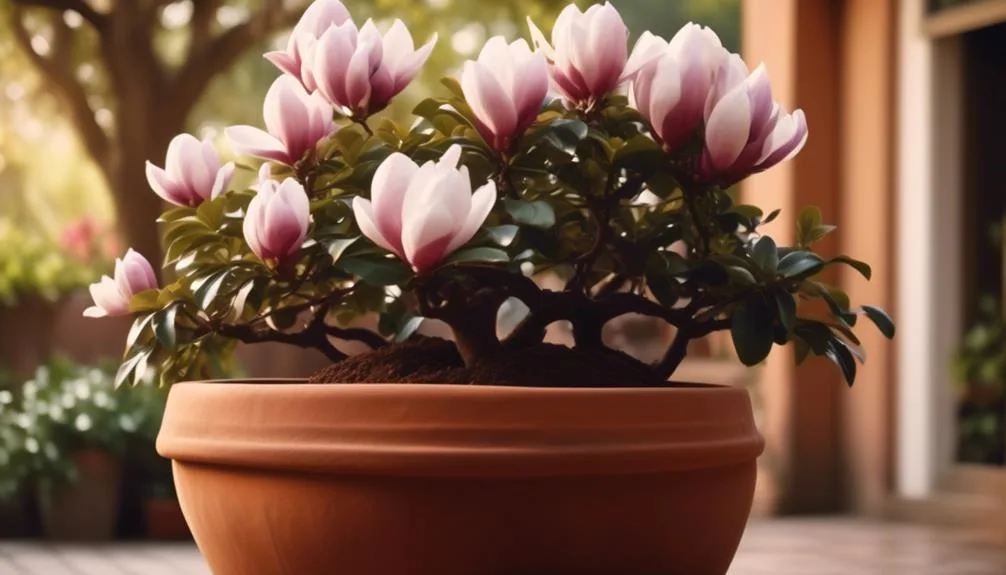Thinking about growing a magnolia tree in a container for your outdoor space? It's possible with the right care. Whether you have limited garden space or want the flexibility to move your magnolia tree around, understanding container gardening for magnolias is essential.
There are key factors to consider. Keep reading to learn more about the ins and outs of successfully growing magnolia trees in containers.
Suitable Magnolia Varieties for Container Growing
When choosing magnolia varieties for container growing, consider the compact and slow-growing options that thrive in limited spaces and can be easily managed. Some suitable varieties for container growing include the Little Gem, which is a compact evergreen variety that does well in containers, and the Jane Magnolia, a slow-growing deciduous variety with stunning purple flowers. These varieties are well-suited for container growing due to their manageable size and adaptability to limited spaces.
For container size, opt for a pot that's at least 2 feet deep and wide to allow ample room for the magnolia's roots to spread and grow.
As for sunlight requirements, select a location that receives full to partial sunlight, as magnolias generally thrive in these conditions.
Choosing the Right Container for Magnolia Trees
Considering the suitable magnolia varieties for container growing, it's essential to choose the right container to ensure the tree's roots have ample space to thrive and expand. When selecting a container for your magnolia tree, keep the following points in mind:
- Container Size: Opt for a large container, at least 2-3 times the size of the tree's current root ball. This allows adequate room for root growth and prevents the tree from becoming root-bound.
- Drainage Requirements: Choose a container with drainage holes to prevent waterlogging, which can lead to root rot. Additionally, consider using a well-draining potting mix to further enhance drainage.
Selecting the right container size and ensuring proper drainage are crucial factors in providing a healthy environment for your magnolia tree to flourish in a container.
Proper Soil and Watering for Magnolia Trees in Containers
To ensure the optimal growth of your magnolia tree in a container, it is crucial to use a well-balanced soil mix and maintain a consistent watering routine. The soil mix should provide good drainage and aeration for the roots. Consider a mix of peat moss, pine bark, and perlite in equal parts. Additionally, the container size plays a crucial role in the tree's health. Choose a container that is at least 2-3 times larger than the magnolia's current root ball to allow for proper root development. When watering, ensure that the soil is consistently moist but not waterlogged. As for fertilizer needs, use a slow-release balanced fertilizer in the spring and mid-summer, following the package instructions. Here's a handy table to summarize the key points:
| Aspect | Consideration |
|---|---|
| Soil Mix | Peat moss, pine bark, perlite in equal parts |
| Container Size | 2-3 times larger than the magnolia's root ball |
| Watering Routine | Keep soil consistently moist, avoid waterlogging |
| Fertilizer Needs | Slow-release balanced fertilizer in spring and summer |
Essential Care and Maintenance for Container-Grown Magnolia Trees
Proper maintenance is essential for ensuring the healthy growth of your container-grown magnolia tree. To keep your magnolia thriving, follow these essential care and maintenance tips:
- Pruning Techniques: Regularly prune dead or damaged branches to promote healthy growth and shape your magnolia tree. Use clean, sharp pruning shears to make clean cuts and avoid tearing the bark.
- Fertilization Schedule: Feed your container-grown magnolia tree with a balanced, slow-release fertilizer in early spring, before new growth appears. Repeat this application in late spring and early summer to support continuous growth and blooming.
- Monitoring and Care: Keep an eye on your magnolia tree for signs of pests, diseases, or nutrient deficiencies. Provide adequate water and ensure the container has proper drainage to prevent waterlogging.
Overwintering and Protection for Magnolia Trees in Containers
As you care for your container-grown magnolia tree during the warmer months, preparing for its protection and well-being through the winter is crucial for its continued health and beauty. Insulating techniques are essential for winterizing your magnolia tree in a container.
One effective method is to wrap the container with insulating materials such as bubble wrap or blankets to shield the roots from freezing temperatures. Additionally, consider frost protection by using covering methods like burlap or frost cloth to shield the tree's branches and foliage from harsh winter conditions.
Ensure that the covering allows for adequate ventilation while providing protection. By employing these winterizing and frost protection strategies, you can help your container-grown magnolia tree withstand the cold months and thrive when the warmer weather returns.
Conclusion
In conclusion, with the right variety, container, soil, and care, magnolia trees can thrive in containers, bringing beauty to even small spaces.
By choosing a suitable variety, providing proper soil and watering, and giving them the care they need, you can enjoy a stunning magnolia tree on your patio or balcony.
Happy gardening!

My interest in trees started when I first saw the giant sequoias in Yosemite.
I was a teenager then, and I remember thinking, “I need to learn more about this.”
That moment stuck with me.
A few years later, I went on to study forestry at Michigan Tech.
Since graduating, I’ve worked in a mix of hands-on tree care and community education.
I’ve spent over ten years helping people understand how to plant, maintain, and protect the trees in their neighborhoods.
I don’t see trees as just part of the landscape.
They are living things that make a real difference in our daily lives.
